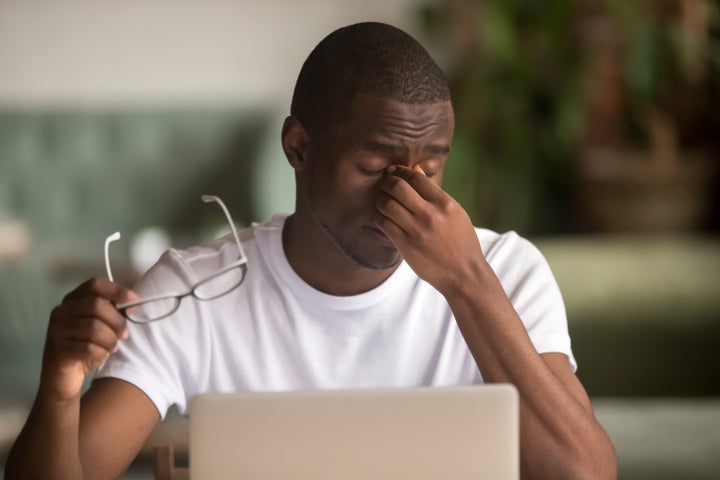If you’ve been working from home for a week or more already, you might have noticed your eyes feeling more tired than usual by the end of the day.
It’s no wonder, really. Many of us are now in proper lockdown mode which means our work, social lives, entertainment and news updates are all being fed to us through screens. And even when you’re not looking at conventional screens (TVs, laptops, phones) there are others vying for your attention such as smart watches and fitness trackers.
Collectively, the nation’s screen time is through the roof and our little peepers can’t take the strain. If your eyes feel like they’ve been hung out to dry by the time 8pm hits, you’ve got screen fatigue.

Nadeem Rob, leading optometrist at London-based opticians, The Eye Establishment, tells HuffPost UK that too much screen time can lead to headaches, eye strain, dry eyes, tiredness and reduced productivity.
“Increased screen time has always been a controversial issue amongst eye care specialists,” says Rob. “Although it hasn’t been proven to damage any aspect of the eye, it is very well accepted that increased screen time adds an unnecessary stress to our efforts.”
Remember Emma – the hunched over, red-eyed office worker of the future? Yep, well, that’s where we’re headed if we don’t do something about it.

Here’s the issue. We are constantly looking at things that are closer to us than further in the distance – and it’s making our eyes work harder as a result. How can you stop this, or at the very least, diminish the negative effects?
“When working on any screen at home or in the office we should remember the 20/20/20 rule,” says Rob. This basically means that after 20 minutes of screen time, you should look outside the window at a distance of 20 feet for 20 seconds – and repeat. This gives our eyes the opportunity to relax.
You could also try eye yoga. Look to the left, hold the position and repeat looking right. Look up, hold the position, repeat looking down. Repeat four times, closing your eyes and relaxing in between. Try this as a break for your eyes throughout the day.
We also need to be mindful of the amount of glare we are exposed to from our screens. “Again, the glare from our screens is not known to damage the eyes but a specific wavelength of blue light increases the effort required for our eyes to function properly,” says Rob.
“Remember to always wear any correction required for near work given by your optometrist, and consider using lenses with blue light filters to reduce the strain and remember to take appropriate breaks.”
Contact lens wearers are advised to switch to glasses when using computers for long periods of time as they are more likely to end up with dry eyes.
In some cases, eye strain can also be caused by excessive sunlight coming in through the window or by bright room lighting, according to Specsavers. If it’s possible, partially close curtains or blinds to reduce the brightness from outside, reduce the lighting in the room, or avoid sitting under big, overhead fluorescent lights. Opticians advise using floor lamps instead.
And it’s not just us grown-ups who might feel the strain over the coming weeks. With more kids turning to homeschooling, young people will be using more online teaching resources. It’s essential that children take regular breaks for their eye health too.
“It has been reported that constant near work by children results in a rise in myopia (shortsightedness),” Rob adds. “Remember to let children rest appropriately to give their eyes a break during the day.”
